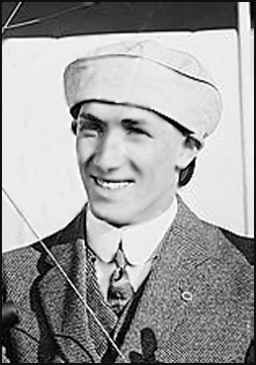
1887-1955 |
 |
|
Library of Congress Archive, 8-3-06 |
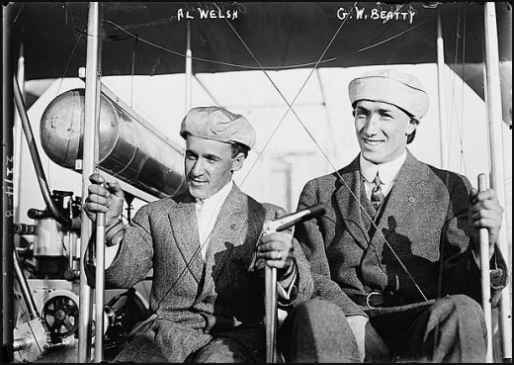 |
|
Library of Congress Archive, 8-3-06 |
 |
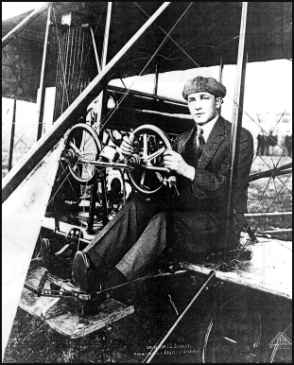 |
My good friend Geo Beatty in his Wright Model at Nassau Boulevard, L.I. 1912 Collection of Frank Schober Courtesy of Margaret Schober Seaman, 3-23-06 |
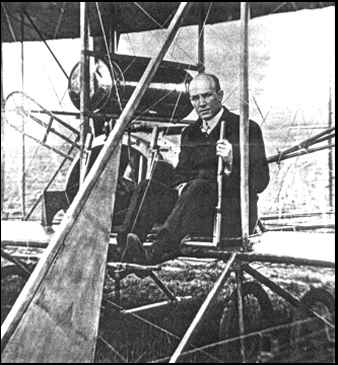 |
|
Photo from biography by Harold E. Morehouse Copy courtesy of Rolland DeRemer, 12-23-03 |
|
Early Wright Exhibition Pilot - Instructor FROM THE FLYING PIONEERS BIOGRAPHIES OF HAROLD E. MOREHOUSE Collection of Rolland DeRemer, 12-23-03 After seeing the flying at various New York air fields and meets in 1910 the flying bug really bit him and he entered the Wright School at Nassau Boulevard, L.I. in the spring of 1911, and was taught to fly by Wright instructor Al Welsh. He started his instruction on June 24th and soloed July 23rd, 1911, and that same day flew as a passenger with Welsh to establish a new American 2-man altitude record of 1,860 feet. Then on August 5th Beatty broke that record, flying to 3,080 feet with Dr. Percy Reynolds as passenger, also winning a cup given by the Farman Co. for duration on the same flight. August 6th he flew for his license, No. 41, and also flew with a passenger from Nassau Boulevard to Long Beach, L.I. and return, using the Wright plane owned by Walter B. Davis. |
 |
|
Grant Park, Chicago (For complete story, click on title) Courtesy of Gary Williams, Air-Racing Writer America's Flyways Magazine 2-24-06 |
|
Following this, he entered the famed Chicago Meet at Grant Park August 12th through 20th. There, on
the first day, Beatty established a new American 2-man endurance record when he flew for 2 hours, 4 minutes. On August 13th he set up
a new world's 3-man record of 1 hour, 18 minutes, and on August 19th broke his own 2-man record when he flew for 3 hours, 19 minutes,
carrying Fred Wagner, a Chicago Tribune News photographer. Beatty was one of the bright stars of the Meet flying a total of 24 hours,
21 minutes during the event to win second place for total duration, exceeded only by Cal Rodgers. That fall Beatty returned to the United States for the winter, but went back to England in February, 1914 where he merged with the well known Handley-Page Co. to open a large flying school at Hendon. He furnished three American Wright machines to add to the Handley-Page equipment and also had the assistance of their previous school instructors. The school prospered and did a flourishing business. World War I was approaching and flight training was much in demand. In 1915 the Beatty School had five assistant insturctors and a large continually graduating class of students. Dual control Beatty Gyro-Wright and Caudron-type tractor biplanes were used. For advanced instruction they also had some special small single-seater tractor biplanes with Gnome engines. During 1915 Beatty also started an aeroplane parts business at Hendon which prospered through World War I, making wing and tail assemblies and various sub-contract work. By 1916 the Beatty Flying School was probably the most popular one in England and going strong. That year he saw the need for a good reliable training engine, so designed and built one which was announced in January, 1917. It was a rugged 4 cyl. 60 H.P. liquid cooled engine, weighing 225 pounds complete. It is not known to what extent this engine was used in his school planes, nor how long he continued work on the project. After World War I the training business slumped and Beatty worked for the British Government for a time in closing out war contracts. In the summer of 1919 he flew exhibitions in several countries on the Continent. He remained in Europe until 1921 then returned to the United States for a visit. Following this Beatty gave up flying, returned to Europe and went into the motorcycle engine business. He soon gained prominence in this field, and in 1923 designed and built a special racing motorcycle which won the Tour de France that year. He remained in the motorcycle business there until the business depression of 1929 forced him out of the field. Returning to the United States Beatty did not find a permanent position until 1934 when he returned to the printing business with the Hughes Printing Company of East Stroudsburg, Pennsylvania. He advanced rapidly to Superintendant with this firm and remained there until he passed away very unexpectedly on February 20, 1955, at age 67. He was survived by his wife, and was buried in Laurelwood Cemetery in Stroudsburg. Early Bird and flying pioneer, George W. Beatty contributed a major share to early American aviation history and richly deserves great credit for his many flying accomplishments. A very active pilot during the early days of aviation, he was best known for his duration and weight carrying flights, and was undoubtedly one of the best known and most capable instructors of that time. A very skillful and careful pilot, he had few accidents and taught countless numbers of fledglings to fly, both here and abroad. His name and the extent of his work will long remain in the annals of aviation history. Due credit is given Mrs. George Beatty for the photo used and a major contibution to htis biography |
 |
|
Names on the hangars include: Ellyson Dietz, Walden, Northwood, and Clarke. Library of Congress Archive, 8-11-08 |
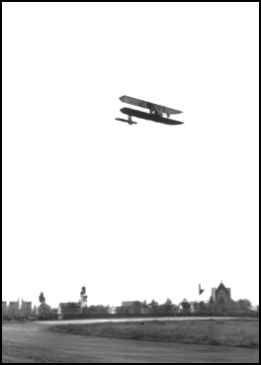 |
 |
|
at the 1911 Brighton Beach Air Meet, at the Brighton Beach Track in New York. Ancient Aviators Website |
Library of Congress Archive, Courtesy of Greg Powers, 8-3-06 |
 |
|
at the 1911 Brighton Beach Air Meet, at the Brighton Beach Track in New York. Ancient Aviators Website |
 |
|
George Beatty landing his Wright Model B biplane at the 1911 Brighton Beach Air Meet during September 8th to 10th. Before World War I, air meets were very popular in the United States of America and many famous aviators would attend them with their airplanes. Some of the other aviators that attended this air meet were Harry Atwood, Tom Sopwith, the English aviator Claude Grahame-White, and Eugene Ely, who was the first pilot to fly and land airplanes from the deck of a ship, which he did, earlier, in 1911. Ancient Aviators Website |
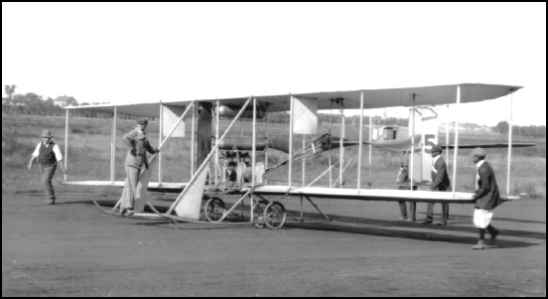 |
|
Ancient Aviators Website |
|
The Daily Times, Chattanooga, Tennessee, May 5, 1912, Transcribed by Bob Davis - 8-12-04 -An accident to the motor of his machine halted the flight of Marshall E. Reid, who started from Hempstead, L.I., this noon, intending to fly to Philadelphia. Near Elizabeth, N.J., during an attempt to descend, the biplane fell and Reid and his passenger, George W. Beatty, were spilled. The machine was wrecked, but neither man was hurt. |
 |
|
Published by Rigot of Chicago, I suspect Aviation Meet 1911 Chicago |
|
|
|
|
|
"Born in 1887 or 1888 in Whitehouse, New Jersey, George W. Beatty was employed as a young man as a linotype operator. He was shortly to enter the field that would define much of his life. In June of 1911 he enrolled at the Wright School at Nassau to be taught by Al Welsh. Soloing on July 23 of that year, he set a new two-man American altitude record on the same day. Throughout that summer, Beatty would set several more records, in altitude, weight-carrying and duration. On August 6, 1911, Beatty obtained license number 41 and subsequently attended meets where he was to break several American and world records. Also in that year, he would become the first to fly a plane in which air to ground communication was maintained throughout the flight." To read the rest of this story on the website of the just click on the title above. |
|
There are two entries for George on the AEROFILES website. You can visit those references by clicking on: George Beatty and using the "Find" function on "Beatty" and George Beatty using the "Find" function on "Beatty" |
|
The star of the meet was to be Walter Brookins. A number of other aviators were scheduled to appear at the Fairgrounds; Andrew Drew and Tom Benoist of St. Louis, John D. Cooper, Charles Zornes, Sax Ganz, C.O. Prowse, and Hillery Beachey, the brother of Toledo aeronaut who had flown dirigibles in St. Louis in 1907 and 1909. In addition, several pupils from Tom Benoist's flying school intended to exhibit their fledgling talents; Harry Rafferty, John Woodlief, Alfred Boullet, B.N. Elsk, and Charles Griffin. Contests for rapid starting, speed, altitude, target bombing, and accurate landing were planned, as well as the usual aerobatics by all participants. The Aero Club of St. Louis scheduled a broader tournament for October 14-21 at Kinloch Park, its permanent aviation field. On September 5, 1911, Albert Bond Lambert signed an agreement with A. Roy Knabenshue, manager of the Wright Company, whereby the Wrights would supply three pilots and biplanes in return for 25 perecent of the gross receipts of the meet. The three aviators -- Howard Gill, J. Clifford Turpin, and P.O. Parmelee -- were to fly every day but October 15, because of the rule of the Wright Company against Sunday flights. Also entered were Dr. Henry Walden of Mineola, Long Island, with his picturesque Antoinette monoplane; Amedee V. Rayburn Jr. of St. Louis with his Bleriot monoplane; Horace Kearney and John D. Cooper of St. Louis with Wright biplanes; George Beatty; and Walter Brookins. The History of Aviation in St. Louis by James J. Horgan The Patrice Press |
|
From The Early Birds of Aviation Roster, 1996 |
|
Recommended Further Reading: CITY OF FLIGHT: The History of Aviation in St. Louis by James J. Horgan Patrice Press |


|